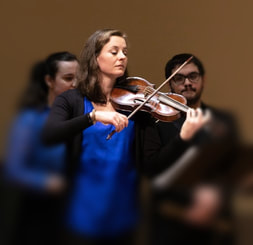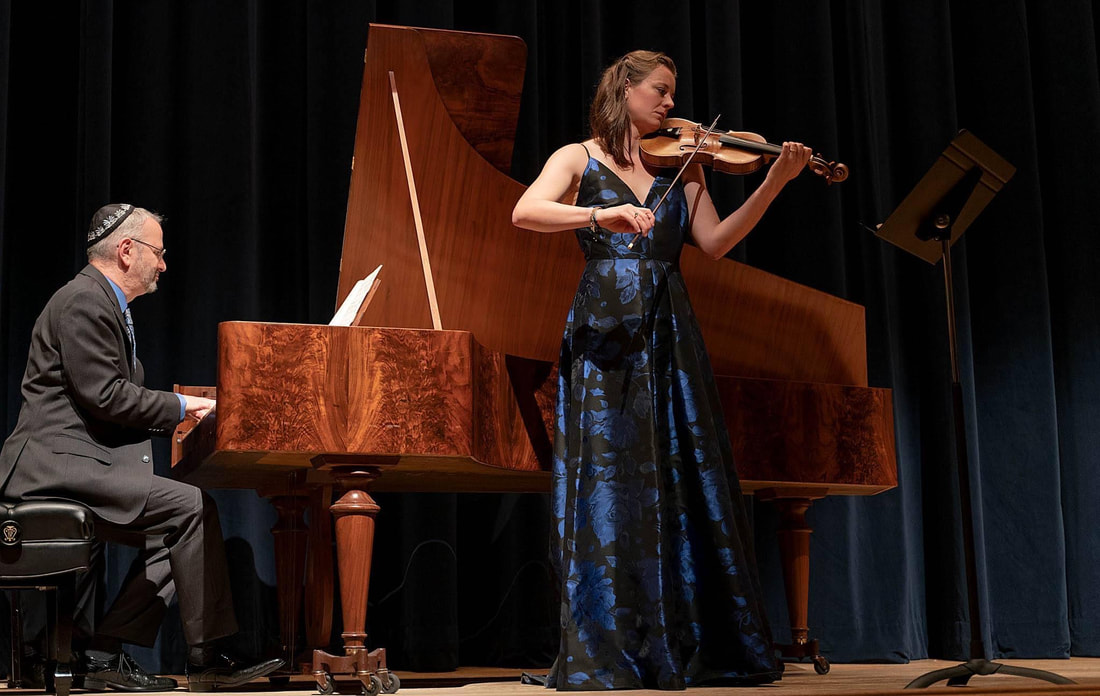
About Sarah's Violin Bags:
These handmade violin bags are a unique design created by a violinist for maximum instrument protection and beauty. These bags come in various prints of all patterns and colors because there is no reason to have a plain instrument bag! Every single bag is made by hand by me, in Bloomington, Indiana.
Not only should your instrument be safe from temperature and humidity fluctuations, I believe you should find joy in opening your case to something beautiful every day!
Each bag has all the stitching on the outside to protect your instrument's varnish. The outside seams are trimmed neatly as part of the industrial strength stitching, so there are no unsightly edges. The top scroll closure (for violins and violas) protects the entire body instead of the traditional bag opening at the base of the instrument, as a the most likely location of cracking will occur by the saddle at the base of the violin/viola or at the sound post. This complete enclosure also protects against open seams in your violin/viola. Each bag is made out of satin or pure silk material in various prints, closes with a matching ribbon, and fits in all regular cases. (If you have an extremely tight-fitting case, or an unusually high chinrest, please message me to ensure we design a bag that fits your violin's situation!) The pure silk bags offer the most protection, especially against humidity changes as this natural fiber is considered to be one of the best natural insulators!
Why use a bag?
A bag for your instrument is the first line of defense against fluctuation in humidity and temperature inside your case. Cases that close with a zipper still allow a draft where the teeth of the zipper close together, and cases that latch closed allow air circulation where the halves of the case meet. In addition to these exposure problems, the new carbon fiber lightweight cases are usually not lined in any kind of velvet or soft fabric (such as Bam Hightech, or the Gewa Idea), and usually do not include a blanket which would put a layer of protection between your violin and your bows. A violin bag ensures more gradual changes for your instrument during storage in the case, and also a layer of protection around the whole violin anytime you're not playing as the entire instrument is enclosed!
Here's a link to a Strings Magazine article explaining the benefits of a silk bag:
How to Winterize Your Instrument
I started making violin bags for myself a few years ago, after encountering trouble with my violin's varnish becoming sticky and changing color due to humidity changes. Once I began playing an older instrument, I noticed it was incredibly temperamental: never staying in tune, and at times I would open the case to find one or more strings had gone slack. Since I started playing baroque violin, gut strings added a new level of stress when traveling, as they are the least stable of any type of string. Because I travel quite a bit with my violins, I needed to find a way to minimize the stress on my instruments from continuously changing humidity levels, seasons, temperatures, and bumps in transit via airplane, car, train, walking, bicycle, etc., anywhere from Colorado to Germany to Indiana to Colombia! Through experimentation with my own violins and cases, I developed a violin bag design that counteracts these problems and lets me worry less about traveling with my instruments.
Your instrument is a serious investment and deserves protection!
These handmade violin bags are a unique design created by a violinist for maximum instrument protection and beauty. These bags come in various prints of all patterns and colors because there is no reason to have a plain instrument bag! Every single bag is made by hand by me, in Bloomington, Indiana.
Not only should your instrument be safe from temperature and humidity fluctuations, I believe you should find joy in opening your case to something beautiful every day!
Each bag has all the stitching on the outside to protect your instrument's varnish. The outside seams are trimmed neatly as part of the industrial strength stitching, so there are no unsightly edges. The top scroll closure (for violins and violas) protects the entire body instead of the traditional bag opening at the base of the instrument, as a the most likely location of cracking will occur by the saddle at the base of the violin/viola or at the sound post. This complete enclosure also protects against open seams in your violin/viola. Each bag is made out of satin or pure silk material in various prints, closes with a matching ribbon, and fits in all regular cases. (If you have an extremely tight-fitting case, or an unusually high chinrest, please message me to ensure we design a bag that fits your violin's situation!) The pure silk bags offer the most protection, especially against humidity changes as this natural fiber is considered to be one of the best natural insulators!
Why use a bag?
A bag for your instrument is the first line of defense against fluctuation in humidity and temperature inside your case. Cases that close with a zipper still allow a draft where the teeth of the zipper close together, and cases that latch closed allow air circulation where the halves of the case meet. In addition to these exposure problems, the new carbon fiber lightweight cases are usually not lined in any kind of velvet or soft fabric (such as Bam Hightech, or the Gewa Idea), and usually do not include a blanket which would put a layer of protection between your violin and your bows. A violin bag ensures more gradual changes for your instrument during storage in the case, and also a layer of protection around the whole violin anytime you're not playing as the entire instrument is enclosed!
Here's a link to a Strings Magazine article explaining the benefits of a silk bag:
How to Winterize Your Instrument
I started making violin bags for myself a few years ago, after encountering trouble with my violin's varnish becoming sticky and changing color due to humidity changes. Once I began playing an older instrument, I noticed it was incredibly temperamental: never staying in tune, and at times I would open the case to find one or more strings had gone slack. Since I started playing baroque violin, gut strings added a new level of stress when traveling, as they are the least stable of any type of string. Because I travel quite a bit with my violins, I needed to find a way to minimize the stress on my instruments from continuously changing humidity levels, seasons, temperatures, and bumps in transit via airplane, car, train, walking, bicycle, etc., anywhere from Colorado to Germany to Indiana to Colombia! Through experimentation with my own violins and cases, I developed a violin bag design that counteracts these problems and lets me worry less about traveling with my instruments.
Your instrument is a serious investment and deserves protection!

A Bit About Sarah:
I am a baroque and modern violinist who plays classical music of all time periods, from the earliest works for violin to new music from living composers.
I have two violins- a German baroque violin from 1703 by Paulus Alletsee and a modern French violin made in Paris in 1927 by J. B. Collin-Mezin.
I make every single bag myself, by hand, out of my Bloomington, Indiana workshop.
What Bags Do I Use?
My baroque violin is currently in a watercolor silk bag inside my Gewa Jaeger case, which I find keeps the violin in tune when I am not playing (always a challenge with gut strings), and my modern violin is in a vintage yellow brocade inside my Gewa Air case. My viola is in an ivory silk charmeuse bag with a hot pink ribbon, inside some unnamed old Heritage heavy hard case.
I am a baroque and modern violinist who plays classical music of all time periods, from the earliest works for violin to new music from living composers.
I have two violins- a German baroque violin from 1703 by Paulus Alletsee and a modern French violin made in Paris in 1927 by J. B. Collin-Mezin.
I make every single bag myself, by hand, out of my Bloomington, Indiana workshop.
What Bags Do I Use?
My baroque violin is currently in a watercolor silk bag inside my Gewa Jaeger case, which I find keeps the violin in tune when I am not playing (always a challenge with gut strings), and my modern violin is in a vintage yellow brocade inside my Gewa Air case. My viola is in an ivory silk charmeuse bag with a hot pink ribbon, inside some unnamed old Heritage heavy hard case.
